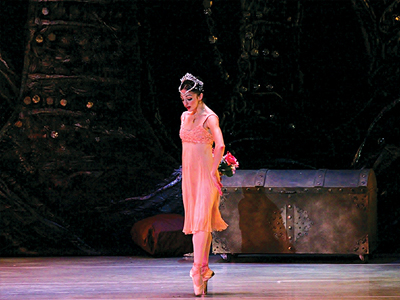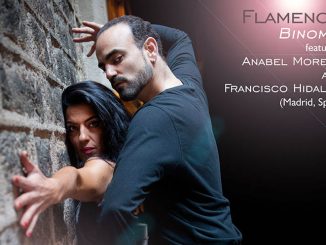Sometimes progress is made by revering the past
 When Pedro Pablo Peña dreams, he dreams big. It is not just his own dance company that he wants in Miami, it must be ballet; and not just ballet but specifically classical ballet. Peña wants entire programs performed to the rigorous, traditional standards taught in the Cuban School of Ballet, and he wants a school dedicated to maintaining Cuban Ballet technique. There is no other way to preserve the virtuosity of this level of dance: “Standards”, he says, “must be maintained.”
When Pedro Pablo Peña dreams, he dreams big. It is not just his own dance company that he wants in Miami, it must be ballet; and not just ballet but specifically classical ballet. Peña wants entire programs performed to the rigorous, traditional standards taught in the Cuban School of Ballet, and he wants a school dedicated to maintaining Cuban Ballet technique. There is no other way to preserve the virtuosity of this level of dance: “Standards”, he says, “must be maintained.”
It is here in Miami that he sets his dream into motion. Peña, as Artistic Director, has assembled a troupe called The Cuban Classical Ballet of Miami (CCBM), located at 900 SW 1st Street, which, since its January 2006 founding, has delivered stunning, critically acclaimed performances. Here his dancers and students perfect the style that exemplifies the Cuban tradition; let other schools and companies offer mere ballet. He will put forward Cuban Ballet as performed by classically trained principal dancers. A company led by exiles who teach other exiles.
“Remember, the Cuban Classical Ballet of Miami is specific to the classical style, the classical ballet style,” Peña says. “Miami City Ballet has a style that is specifically Balanchine. And also, for the Cuban Classical, the more important aspect is the focus, the legacy of the Cuban ballet… It’s a mix: the different schools have different techniques. The Cuban Ballet School offers a specific formation for its dancers.” This formation that he speaks of is actually an amalgamation of studies from other schools layered with Cuban artistry and technique.
It is the Cuban interpretation of the French, Italian and American schools what actually brought forth not only artistic rigor, but also a distinct sensuality and emotional knowledge that went beyond mere technique, beyond even exceptional technique. Always present was the dancer’s demand to move through space as a brilliant, unified body, and not one where body parts moved exactly, separately, through rehearsed motion; it is this sensibility, this demand for physical and emotional perfection, that Peña instills in his dancers and students. The need to express traditional dancing goes hand in hand with producing the traditional ballet repertoire with programs such as Swan Lake and Giselle – and all the challenges that go with it.
The number one task his company faces is the funding of this artistic vision. “In reality, I don’t have a specific budget. For some productions, you can put on the ballet for a minimal cost – the costs for a production can go up to $200,000 because classical is expensive,” he says. “I have a budget for different performances: a budget for the full-length (ballet) of the year – one full-length of the year – and another performance, too. The best of the classical repertoire.”
“For the costumes, for example, I’ve rented costumes… Sometimes I bring in the orchestra. It’s a lot. It’s expensive… if you put on Swan Lake, the ballet of Tchaikovsky, the minimal number of musicians used for the production is fifty-something. You can’t do it with forty or thirty-six or forty-two! Impossible! For Tchaikovsky, it’s necessary for the musicians to sound good.”
Cuban Classical Ballet of Miami is a non-profit 501(C)(3) organization and tries to keep administrative expenses low, but the budget to put on expensive productions and pay employees must be met. Costs are defrayed by holding auctions of artwork and finding sponsors, most notably American Airlines, which also sponsors Peña’s annual International Ballet Festival, now in its 15th year. CCBM can meet its financial obligations, but Peña wishes, especially in this economic climate, that more help were forthcoming, saying, “The situation in the United States makes fundraising difficult, but I think the government or the city, for the betterment, should help the arts more in Miami.”
All this time, effort, and money go toward making South Florida a place of cultural elegance. And therein lies another hurdle: Miami itself. Peña has a vision of Miami where change makes it a cultural mecca. “I think it’s my responsibility – an artistic responsibility – to contribute to the necessary changes that make our vision real. I’ve lived here twenty-something years, and I bring Miami the best in the arts in the ballet. I work here in Miami for its culture and, specifically, because I think classical ballet is a necessity for everybody. It’s my responsibility as an artist to do that.”
Having Miami such a large Latino population, Peña believes deeply that he must invest in the city and be a part of its cultural diversity. Miamians have started to demand world-class artistry, and offering traditional Cuban ballet hugely increases high-end options. His efforts to secure Cuban ballet for Miamians has paid off well: Peña notes that his audiences are filled.
“The people absolutely love the classical ballet. My audience, I think, is Anglo, American Anglo. The Cubans have a tradition of going to the ballet. Young people, too, not just old people. There’s diversity, absolutely.”
Diversity is brought also to the programs themselves with the addition of guest dancers from around the world. For the 2009 season, the full-length spectacular Le Corsaire, was given its South Florida premiere. Additional dancers for this production came from companies in Berlin, the Republic of Slovenia, and Rio de Janeiro.
More collaboration with other companies can be seen in other CCBM productions. The upcoming premiere of the full-length Don Quixote, which will take place on May 22nd and 23rd at the The Fillmore Miami Beach at the Jackie Gleason Theater, will be presented in conjunction with Cia Brasileira de Ballet, a company from Rio de Janeiro, which is also making its Miami debut.
Peña radiates with pride at his upcoming production, “It’s the full length, with the orchestra, too… Great costumes and great sets. And also, Cia Brasileira is working together with us. This is very important, because in Brazil there is a lot of talent for dancers. Incredible!”
It is not just collaboration with other companies that helps keep the artistry fresh and alive, even more change is on the way. Toward the end of 2010, the company will relocate to a historically recognized colonial-style building, the J. W. Warner House, which is located at 111 SW 5th Avenue, and will serve as headquarters for both the company and the ballet school, which is yet another investment toward the future. Ballet students at the CCBM have the chance, under the direction of Peña and Magaly Suarez, the Artistic Director, to learn Cuban Ballet. Scholarships will be offered for tuition assistance through Miami Dade College and still, more studies can be obtained through various workshops and tutorials.
It is through these many avenues that a student can learn the tremendous legacy of Cuban Ballet and can master the demands of a performance, but above all this, is the need to give themselves up to the art. “The career of a dancer is sacrifice,” says Peña. “The feeling for the dance is very important. Sacrifice. And love the dance. If you don’t fall in love with the dance, you cannot do it.”
Peña is overcome with the need to inspire. As it was taught to him in Cuba, he will teach to his students as a link connecting the past to with the future.
“This is my life. I don’t have another life but dancing. My legacy is how I work with love. This is more important. When you love what you do, you are never doing ‘nothing’. This is my best message, I leave this legacy, when you love the dancers.”



Be the first to comment